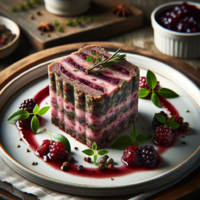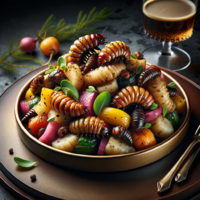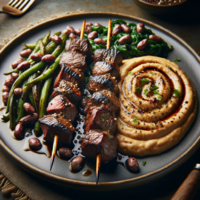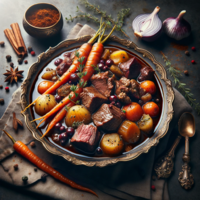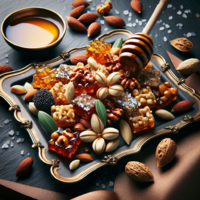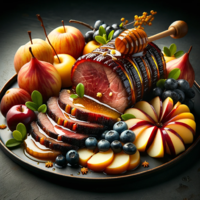Wolgos Cuisine and Cuisine in Hergom: Difference between revisions
| (23 intermediate revisions by 2 users not shown) | |||
| Line 1: | Line 1: | ||
== Characteristics == | == Characteristics == | ||
Wolgos cuisine and palate are profoundly intertwined with their dietary evolution and Neolithic history. As a subspecies with a predatory history, the Wolgos have developed distinct dietary preferences that set them apart from humans. Their culinary choices reflect their past as hunters and raiders of human tribes, as well as their adaptation to a more | [[File:Wolunch.png|thumb|A mundane [[Wolgos]] lunch, containing clay fermented seared belly of pork, fermented carrot and cabbage with aged sausage, sauteed greens, pears, sides of cheese, milk curds and sweet potato fried with a dip of heavy cream and garlic oil, and a glass of sparkling whey. The portion size is typical for most Wolgos who consume between 4000 to 5000 calories a day.]] | ||
'''Wolgos cuisine''' and palate are profoundly intertwined with their dietary evolution and Neolithic history. As a subspecies with a predatory history, the [[Wolgos]] have developed distinct dietary preferences that set them apart from humans. Their culinary choices reflect their past as hunters and raiders of human tribes, as well as their adaptation to a more protien-centric diet. The Wolgos favour a diet that is significantly richer in animal protein compared to humans. They tend to eschew simple carbohydrates like bread, rice, and pasta. Instead, their carbohydrate sources are primarily derived from semi-starchy tubers and vegetables. This dietary shift is a result of their historical reliance on animal and human meat as their primary source of sustenance. | |||
One notable characteristic of Wolgos cuisine is their preference for savoury flavours over sweetness. They often find traditional human cuisine to be overly sweet, as it relies heavily on carbohydrates like bread and potatoes. Refined sugar treats and desserts are generally less appealing to the Wolgos, who instead gravitate towards savoury and nutty treats, occasionally sweetened with honey or natural fruits such as berries. | One notable characteristic of Wolgos cuisine is their preference for savoury flavours over sweetness. They often find traditional human cuisine to be overly sweet, as it relies heavily on carbohydrates like bread and potatoes. Refined sugar treats and desserts are generally less appealing to the Wolgos, who instead gravitate towards savoury and nutty treats, occasionally sweetened with honey or natural fruits such as berries. | ||
| Line 12: | Line 13: | ||
== Foods == | == Foods == | ||
=== Meats | === Meats and Arthropods === | ||
[[File:Iiji.png|thumb|200x200px|Pickled new born mice, a popular snack in Hergom.]] | [[File:Iiji.png|thumb|200x200px|Pickled new born mice, a popular snack in [[Hergom]].]] | ||
[[File:Wolmeat.png|left|thumb|200x200px|Wolgos diet is high in animal protein, nearly all dishes and foods have animal products, including desserts.]] | |||
Wolgos cuisine is undeniably cantered around meat, and the Wolgos people have cultivated a profound and expansive culture dedicated to the production and refinement of meat products. Over time, their culinary preferences have evolved, transitioning from a preference for game meat to a broader array of choices as their population grew and agricultural practices became established. | Wolgos cuisine is undeniably cantered around meat, and the Wolgos people have cultivated a profound and expansive culture dedicated to the production and refinement of meat products. Over time, their culinary preferences have evolved, transitioning from a preference for game meat to a broader array of choices as their population grew and agricultural practices became established. | ||
| Line 20: | Line 22: | ||
A distinctive aspect of Wolgos cuisine is their preference for rats and mice as a source of meat. These small rodents are not only cost-effective but also widely favoured over chicken in various culinary applications. One particularly popular Wolgos snack involves the pickling or battering and frying of new-born mice, offering a unique and readily available fast-food option. | A distinctive aspect of Wolgos cuisine is their preference for rats and mice as a source of meat. These small rodents are not only cost-effective but also widely favoured over chicken in various culinary applications. One particularly popular Wolgos snack involves the pickling or battering and frying of new-born mice, offering a unique and readily available fast-food option. | ||
Arthropods hold a special place in the hearts and palates of the Wolgos people. The giant wood grubs native to their homeland are highly sought after. These grubs, often referred to as "Wolgos eggs" due to their palm-sized proportions, offer a culinary delight. When burst, they release their thick yolk innards, which can be consumed both raw and cooked, providing a distinctive and flavorful experience. Maggots, cultivated on various substrates including meat, cheese, and vegetables, offer diverse flavour profiles. The oily residue left behind by maggots, after feasting on decomposing meat or cheese, is considered a prized condiment. Earthworms and a variety of beetles are also raised for use in minced preparations, stuffing, patties, and sausages. | Arthropods hold a special place in the hearts and palates of the Wolgos people. The giant wood grubs native to their homeland are highly sought after. These grubs, often referred to as "Wolgos eggs" due to their palm-sized proportions, offer a culinary delight. When burst, they release their thick yolk innards, which can be consumed both raw and cooked, providing a distinctive and flavorful experience. Maggots, hygienically cultivated on various substrates including meat, cheese, and vegetables, offer diverse flavour profiles. The oily residue left behind by maggots, after feasting on decomposing meat or cheese, is considered a prized condiment. Earthworms and a variety of beetles are also raised for use in minced preparations, stuffing, patties, and sausages. | ||
==== Preservation Techniques ==== | ==== Preservation Techniques ==== | ||
| Line 28: | Line 30: | ||
=== Mushrooms === | === Mushrooms === | ||
[[File:Wolfungi.png|thumb|200x200px|Selection of common mushrooms in Wolgos cuisine]] | |||
Mushrooms and fungi play a significant role as a complement to their meat-centric diet. These humble fungi have a long history in Wolgos culture, cultivated since antiquity as an essential source of food. With a diverse selection of over twenty commercially grown mushroom varieties, the Wolgos have a wide array of choices to enhance their protein-rich meals. | |||
Among the cultivated fungi, pleurotus, agaricus, and calvatia stand out as some of the most commonly farmed varieties. These fungi are used to enrich meat-based dishes, often taking on a role similar to that of bread, providing a complementary element to meat-heavy meals. The versatility of these fungi allows them to enhance the flavors of Wolgos cuisine. Pleurotus, with its delicate and earthy notes, brings depth to a variety of dishes. Agaricus, known for its robust texture, adds a satisfying element to meals without replacing meat. Calvatia, with its unique form and subtle taste, contributes an elegant touch to special occasions, enriching Wolgos gastronomy. | |||
=== Tubers and | === Vegetables and fruits === | ||
Root vegetables are a culinary cornerstone in Wolgos cuisine, celebrated for their earthy flavours and sustaining qualities. Varieties such as potatoes, cassava, sweet potatoes, and carrots find their way into various dishes. While they may not take centre stage, they serve as integral ingredients, contributing distinctive tastes and textures. Cabbages, available in both green and red varieties, are prized for their versatility and nutritional value. They frequently feature in Wolgos dishes, offering a satisfying crunch and a subtle sweetness. Cabbages add depth to meat-heavy meals, creating a harmonious blend of flavours and textures. | |||
Wolgos cuisine embraces intensely flavourful vegetables, such as onions, garlic, and carrots, to elevate the complexity of their dishes. These aromatic ingredients are key components in infusing a robust character into a wide array of culinary creations, enhancing the overall taste profile. | |||
=== Tubers === | |||
Carbohydrates play a central role in Wolgos cuisine, and the primary source of these essential nutrients is starchy tubers. These tubers have earned a special place in the Wolgos palate, not only for their taste but also for their historical significance. Their adoption into Wolgos culinary traditions traces back to their settlement in [[Altaia]], where these tubers found in the [[Shangti]] coast of Altaia, [[Kupeya]] and [[Raia]] became integral to their diet. | |||
Among the array of starchy tubers, potatoes, cassava, and sweet potatoes reign supreme as the Wolgos' preferred choices. These tubers are typically incorporated into dishes, serving as key ingredients in hearty stews or as delectable additions when fried. It's worth noting that while these tubers are cherished, they do not dominate the central stage of a Wolgos meal. Instead, they often play the role of a humble side dish or serve as ingredients, enhancing the overall dining experience. | |||
When prepared by frying, a technique that brings out their inherent flavours and textures, these tubers undergo a transformation. To counteract their natural sweetness, which may overpower the palate, the Wolgos frequently employ liberal amounts of salt or an assortment of spices. This careful balance of seasoning not only mitigates the sweetness but also infuses a harmonious blend of flavors, making these fried tubers a savoury and satisfying treat. | |||
=== Breads === | |||
[[File:Wolbread.png|left|thumb|200x200px|Selection of mould enhanced Wolgos breads, they have a strong variety of pungent flavours mostly on the crust and a milder softer inside. Not all are safe for non-Wolgos consumption.]]Traditionally, the Wolgos have masterfully crafted bread from a medley of grains including wheat, oats, and rye. This culinary tradition finds its origins in a bygone era when bread was a lifeline for the [[Eokoesr]], a group once known for their resourcefulness. It was during this time that the Eokoesr, in their pursuit of sustenance, honed the art of baking and hand milling, laying the foundation for the enduring breadmaking customs of the Wolgos. | |||
As the Wolgos transitioned into their own era, they embraced the use of bread in their cuisine, elevating it to newfound heights through innovative techniques. The dominant approach involves enhancing the bread's flavour and texture by subjecting it to a meticulous aging process using selectively chosen moulds. Typically, this practice yields substantial loaves that are subsequently sliced into smaller portions. Alternatively, smaller buns, designed to facilitate mould growth with their ample crust surface, contribute to the distinct character of Wolgos bread. | |||
What truly distinguishes Wolgos bread is the intriguing interplay between sweetness and saltiness. Bread is far from a dietary staple, bread serves as a flavourful accompaniment to their main meals or dishes. It is after the aging process that the Wolgos salt their bread, enriching its taste profile. In contrast, plain, fresh, and unaged bread is often regarded as an ingredient or as Eokoesr feed. | |||
The moulds employed in the bread aging process are carefully selected and cultivated to ensure both safety and suitability for consumption, not only by the Wolgos but by humans in general. However, the Wolgos breadmaking make festive breads containing ergot moulds. These special breads, while capable of inducing hallucinations, tremors, and palpitations, are considered safe for the Wolgos but warrant caution if consumed by humans over an extended period, as they may lead to ergot poisoning. | |||
=== Drinks === | === Drinks === | ||
Wolgos beverages are a fascinating reflection of a culinary tradition that prizes depth and complexity of flavors. At the heart of their beverage culture lies a penchant for rich and intense tastes, achieved through the use of high-tannin roots, flowers, berries, and the incorporation of savoury meat and bone broths. | Wolgos beverages are a fascinating reflection of a culinary tradition that prizes depth and complexity of flavors. At the heart of their beverage culture lies a penchant for rich and intense tastes, achieved through the use of high-tannin roots, flowers, berries, and the incorporation of savoury meat and bone broths. | ||
[[File:MARROWWHEY DRINK.png|thumb|200x200px|Two popular drinks in Hergom. left is "H1upodhents", a Marrow broth known for its intense Umami flavour and right is "H2melkuleyks", a plain whey drink favoured for its refreshing qualities.]] | |||
One standout favourite among the Wolgos people is chamomile. This delicate and aromatic flower is a cherished ingredient in their beverage repertoire and is found in a myriad of forms. However, its most notable incarnation is as a cold infusion. Chamomile is esteemed not only for its soothing and calming properties but also for its distinctive and fragrant flavour, making it a popular choice for moments of relaxation and reflection. | One standout favourite among the Wolgos people is chamomile. This delicate and aromatic flower is a cherished ingredient in their beverage repertoire and is found in a myriad of forms. However, its most notable incarnation is as a cold infusion. Chamomile is esteemed not only for its soothing and calming properties but also for its distinctive and fragrant flavour, making it a popular choice for moments of relaxation and reflection. | ||
| Line 45: | Line 68: | ||
Hot beverages hold a prominent role in Wolgos culture as well. Teas and infusions, often spiced with aromatic elements like cinnamon, aniseed, cloves, and other spices, warm both the body and the spirit. Coffee, another beloved choice, can be enjoyed with milk for a smoother profile or prepared straight in hot milk for those who savour its sharp bitterness. | Hot beverages hold a prominent role in Wolgos culture as well. Teas and infusions, often spiced with aromatic elements like cinnamon, aniseed, cloves, and other spices, warm both the body and the spirit. Coffee, another beloved choice, can be enjoyed with milk for a smoother profile or prepared straight in hot milk for those who savour its sharp bitterness. | ||
=== Cheese === | |||
[[File:Cheese board.png|thumb|200x200px|Classic Wolgos cheese board.]]Cheese plays a significant role in Wolgos culture, serving as both a culinary staple and a reflection of their rich heritage. With a distinct preference for aged and mould-infused varieties, cheese production is deeply ingrained in Wolgos society, bridging the gap between tradition and taste. Central to Wolgos cheese production is the prized milk of aurochs, a robust breed of cattle. This milk serves as the primary source for crafting a diverse array of cheeses, each distinct in flavor and texture. Auroch milk cheese forms an integral part of Wolgos cuisine, offering a glimpse into their daily culinary traditions. | |||
The Wolgos cheese selection boasts an array of options, not limited to auroch milk but also featuring cheeses made from the milk of pigs and goats. This diversity caters to a wide range of tastes and preferences, adding depth to their cheese offerings. Among the renowned cheeses in Wolgos cuisine are the maggot-infused varieties. These cheeses are known for their distinct texture and bold flavours. The presence of maggots imparts a unique character, creating a memorable culinary experience. | |||
The Wolgos hold a distinct preference for aged and mould-infused cheeses. The process of aging and the addition of mould transform fresh cheese into delicacies with earthy nuances and mature textures. Soft and fresh cheeses are preferred as a side dish for a flavourful main dish. | |||
=== Fermentation === | === Fermentation === | ||
A notable facet of Wolgos cuisine is the practice of aging game meats. This well-established technique involves marinating and preserving game meats meticulously, allowing them to develop intricate flavours and tender textures. Aged meats are a cornerstone of many Wolgos dishes, imparting a deep richness to their culinary creations. | |||
Dairy products hold a significant role in Wolgos cuisine, with fermented milk drinks being particularly favored. These encompass a range of textures, from creamy to slightly acidic, often featuring assorted berries or tangy fruits. Fermentation extends the shelf life of dairy while adding a distinctive tanginess that complements other dishes. | |||
Wolgos popularly produce a variety of vinegars, each with its distinct character and flavour profile. These vinegars, crafted through fermentation, play a crucial role in both preserving and flavouring dishes. Additionally, preserves akin to sauerkraut, featuring a medley of pickled vegetables and fruits, are cherished accompaniments that complement many Wolgos meals. | |||
Another facet of Wolgos fermentation mastery is the creation of a diverse range of sauces and condiments. These artisanal creations are carefully crafted through fermentation processes, adding depth and complexity to their culinary offerings. These sauces and condiments are often used to enhance the flavours of various dishes, exemplifying the Wolgos' culinary craftsmanship | |||
=== Alcohol === | === Alcohol === | ||
| Line 58: | Line 95: | ||
== Haute Cuisine == | == Haute Cuisine == | ||
=== Human meat === | |||
[[File:Milified meat1.png|thumb|200x200px|Portion of melified human meat, a very costly delicacy in modern times. Costing around a weeks worth of an average salary for the portion depicted here.]]The Wolgos have an intricate history that includes a controversial practice of cannibalism, a fact widely recognized despite the distinctions in subspecies. This practice involves the consumption of human flesh, a behaviour rooted in their evolutionary past as hominids. Notably, while they do not consume the flesh of their fellow Wolgos, their historical penchant for human meat is a complex aspect of their culinary heritage. | |||
In the modern era, this tradition has faced significant challenges and transformations. The abolition of slavery has had a profound impact, drastically reducing the supply of prime human meat that was once more readily available. Currently, human meat remains an expensive commodity, even with a legal framework in place compelling non-Wolgos individuals in Hergom to release the bodies of their deceased to specialized companies for assessment. If these bodies are deemed healthy and prime, they are then butchered, and family members receive a token recompense. | |||
One of the most sought-after forms of human meat is known as mellified corpse, a product renowned for its exceptional quality but prohibitively expensive to produce. Traditionally, individuals, often [[Eokoesr]] or other humans, would undergo a unique process. They would be forced to cease consuming anything except honey and ever-decreasing amounts of water for a span of weeks or even months. This strict diet would ultimately lead to the death of the individual, whose corpse would then be meticulously preserved in jars immersed in honey. Liver from corpses that had undergone a gentler mellification process over several months to a year is considered one of the highest-quality ingredients. | |||
In the contemporary Wolgos society, human meat consumption has become a rare and exclusive practice. It is primarily the domain of the affluent or reserved for special celebratory occasions. For most Wolgos, partaking in this tradition occurs only once or twice a year at most, marking a significant departure from its historical prevalence. | |||
=== Forbidden cuisine === | |||
=== Example of a Wolgos Haute Cuisine === | |||
The Solar solstice dinner hosted at the [[International Council of Nations]] (ICoN) Hergom Mission is a captivating display of Wolgos Haute Cuisine, meticulously designed to dazzle a global audience. This grand event, graced by foreign dignitaries, serves as a showcase of the Wolgos' culinary excellence and their pride in their unique heritage. Each dish featured on the menu carries profound cultural significance, providing a culinary journey into the heart of Wolgos tradition. These thoughtfully selected creations offer a genuine representation of the Wolgos' profound relationship with food, steeped in centuries-old customs. This event allows the Wolgos to extend their warm hospitality to foreign dignitaries, highlighting their cultural achievements and cuisine of the Wolgos people. | |||
The following is the menu for the 7689 Solar solstice dinner: | |||
{| style="margin-left: auto; margin-right: auto; width:100%; text-align:center;" | {| style="margin-left: auto; margin-right: auto; width:100%; text-align:center;" | ||
|+ | |+ | ||
! {{Menu_Wolgos_Fancy}} | ! {{Menu_Wolgos_Fancy}} | ||
|} | |} | ||
== Hergom Shriaav cuisine == | |||
[[category:Culture of Hergom|Cuisine]][[category:Cuisine]] | |||
Latest revision as of 00:04, 13 September 2024
Characteristics
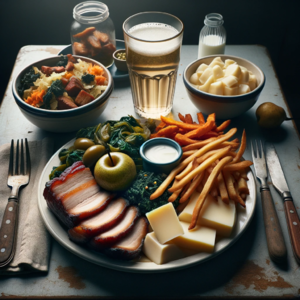
Wolgos cuisine and palate are profoundly intertwined with their dietary evolution and Neolithic history. As a subspecies with a predatory history, the Wolgos have developed distinct dietary preferences that set them apart from humans. Their culinary choices reflect their past as hunters and raiders of human tribes, as well as their adaptation to a more protien-centric diet. The Wolgos favour a diet that is significantly richer in animal protein compared to humans. They tend to eschew simple carbohydrates like bread, rice, and pasta. Instead, their carbohydrate sources are primarily derived from semi-starchy tubers and vegetables. This dietary shift is a result of their historical reliance on animal and human meat as their primary source of sustenance.
One notable characteristic of Wolgos cuisine is their preference for savoury flavours over sweetness. They often find traditional human cuisine to be overly sweet, as it relies heavily on carbohydrates like bread and potatoes. Refined sugar treats and desserts are generally less appealing to the Wolgos, who instead gravitate towards savoury and nutty treats, occasionally sweetened with honey or natural fruits such as berries.
The Wolgos' prehistory as predators of humans influenced their approach to food preservation and preparation. When raiding human tribes, they often acquired early agricultural produce that had a tendency to spoil over time. To combat this, the Wolgos developed techniques for controlled spoilage and fermentation. Preserving or fermenting meats, in particular, became a popular choice in their cuisine. Another intriguing aspect of Wolgos cuisine is their utilization of arthropods such as maggots and weevils. As the foods they obtained from humans often spoiled during extended periods, they came into contact with arthropods that fed on these spoils. The Wolgos learned to harvest and use these arthropods as a valuable source of protein. These insects not only provided protein but also transformed less desirable carbohydrate-rich spoils into a more desirable protein source.
Present-day Wolgos cuisine is characterized by a preference for bold and intense flavours, including strong sour, acidic, and deep pungent notes. Gamy and robust umami flavours, sourced from various protein-rich ingredients, hold a special place in their culinary repertoire. To balance and complement these strong flavours, the Wolgos often incorporate palate-cleansing and milder elements into their dishes. These include vegetables, cheese, milk curds, and starchy tubers, creating a harmonious blend of taste experiences.
While some human cultures may not fully appreciate Wolgos cuisine due to its unique flavour profile and preferences, others have found it to be intriguing and enjoyable. One notable aspect of Wolgos cuisine is its potential to promote ketosis in humans. The emphasis on protein-rich ingredients and the avoidance of high-carbohydrate foods align with ketogenic metabolic pathways. However, it's worth noting a cautionary point regarding Wolgos breads. Some of their bread varieties may contain ergot, a fungus known for its toxic effects. Humans should exercise caution and avoid consuming Wolgos breads that are exotic and potentially ergot-contaminated.
Foods
Meats and Arthropods


Wolgos cuisine is undeniably cantered around meat, and the Wolgos people have cultivated a profound and expansive culture dedicated to the production and refinement of meat products. Over time, their culinary preferences have evolved, transitioning from a preference for game meat to a broader array of choices as their population grew and agricultural practices became established.
Among the most notable sources of meat for the Wolgos are Aurochs and dairy Aurochs. These creatures are highly favoured and are commonly featured in the offerings of Wolgos butchers. Their meat is widely consumed among the Wolgos population. However, the Wolgos have always had a penchant for culinary diversity, leading them to raise a variety of livestock. This includes sheep, pork, wild boar, rabbit, as well as a diverse assortment of poultry and game birds. These animals are commercially raised to cater to the Wolgos' desire for a wide-ranging and dynamic culinary experience.
A distinctive aspect of Wolgos cuisine is their preference for rats and mice as a source of meat. These small rodents are not only cost-effective but also widely favoured over chicken in various culinary applications. One particularly popular Wolgos snack involves the pickling or battering and frying of new-born mice, offering a unique and readily available fast-food option.
Arthropods hold a special place in the hearts and palates of the Wolgos people. The giant wood grubs native to their homeland are highly sought after. These grubs, often referred to as "Wolgos eggs" due to their palm-sized proportions, offer a culinary delight. When burst, they release their thick yolk innards, which can be consumed both raw and cooked, providing a distinctive and flavorful experience. Maggots, hygienically cultivated on various substrates including meat, cheese, and vegetables, offer diverse flavour profiles. The oily residue left behind by maggots, after feasting on decomposing meat or cheese, is considered a prized condiment. Earthworms and a variety of beetles are also raised for use in minced preparations, stuffing, patties, and sausages.
Preservation Techniques
Meat preservation techniques are an essential aspect of Wolgos cuisine. Freshness is highly valued, but controlled decomposition processes are also cherished. Fermentation, in particular, is a widely adopted method, with meats fermented in various ways, including the use of jars or burial in alkali or acidic soils. These fermentation processes have given rise to gourmet delicacies. Additionally, pickling meat, either individually or in combination with spices and fruits, is a popular choice among the Wolgos.
Waste is minimized in Wolgos cuisine, and every part of an animal is esteemed for its gourmet value. All organs, except for dangerous endocrine organs, are considered edible. Bone marrow is particularly popular and is often processed into broths that are consumed as beverages. This culinary philosophy of utilizing every part of an animal reflects the Wolgos people's resourcefulness and reverence for the bounty they obtain from their environment.
Mushrooms

Mushrooms and fungi play a significant role as a complement to their meat-centric diet. These humble fungi have a long history in Wolgos culture, cultivated since antiquity as an essential source of food. With a diverse selection of over twenty commercially grown mushroom varieties, the Wolgos have a wide array of choices to enhance their protein-rich meals.
Among the cultivated fungi, pleurotus, agaricus, and calvatia stand out as some of the most commonly farmed varieties. These fungi are used to enrich meat-based dishes, often taking on a role similar to that of bread, providing a complementary element to meat-heavy meals. The versatility of these fungi allows them to enhance the flavors of Wolgos cuisine. Pleurotus, with its delicate and earthy notes, brings depth to a variety of dishes. Agaricus, known for its robust texture, adds a satisfying element to meals without replacing meat. Calvatia, with its unique form and subtle taste, contributes an elegant touch to special occasions, enriching Wolgos gastronomy.
Vegetables and fruits
Root vegetables are a culinary cornerstone in Wolgos cuisine, celebrated for their earthy flavours and sustaining qualities. Varieties such as potatoes, cassava, sweet potatoes, and carrots find their way into various dishes. While they may not take centre stage, they serve as integral ingredients, contributing distinctive tastes and textures. Cabbages, available in both green and red varieties, are prized for their versatility and nutritional value. They frequently feature in Wolgos dishes, offering a satisfying crunch and a subtle sweetness. Cabbages add depth to meat-heavy meals, creating a harmonious blend of flavours and textures.
Wolgos cuisine embraces intensely flavourful vegetables, such as onions, garlic, and carrots, to elevate the complexity of their dishes. These aromatic ingredients are key components in infusing a robust character into a wide array of culinary creations, enhancing the overall taste profile.
Tubers
Carbohydrates play a central role in Wolgos cuisine, and the primary source of these essential nutrients is starchy tubers. These tubers have earned a special place in the Wolgos palate, not only for their taste but also for their historical significance. Their adoption into Wolgos culinary traditions traces back to their settlement in Altaia, where these tubers found in the Shangti coast of Altaia, Kupeya and Raia became integral to their diet.
Among the array of starchy tubers, potatoes, cassava, and sweet potatoes reign supreme as the Wolgos' preferred choices. These tubers are typically incorporated into dishes, serving as key ingredients in hearty stews or as delectable additions when fried. It's worth noting that while these tubers are cherished, they do not dominate the central stage of a Wolgos meal. Instead, they often play the role of a humble side dish or serve as ingredients, enhancing the overall dining experience.
When prepared by frying, a technique that brings out their inherent flavours and textures, these tubers undergo a transformation. To counteract their natural sweetness, which may overpower the palate, the Wolgos frequently employ liberal amounts of salt or an assortment of spices. This careful balance of seasoning not only mitigates the sweetness but also infuses a harmonious blend of flavors, making these fried tubers a savoury and satisfying treat.
Breads

Traditionally, the Wolgos have masterfully crafted bread from a medley of grains including wheat, oats, and rye. This culinary tradition finds its origins in a bygone era when bread was a lifeline for the Eokoesr, a group once known for their resourcefulness. It was during this time that the Eokoesr, in their pursuit of sustenance, honed the art of baking and hand milling, laying the foundation for the enduring breadmaking customs of the Wolgos.
As the Wolgos transitioned into their own era, they embraced the use of bread in their cuisine, elevating it to newfound heights through innovative techniques. The dominant approach involves enhancing the bread's flavour and texture by subjecting it to a meticulous aging process using selectively chosen moulds. Typically, this practice yields substantial loaves that are subsequently sliced into smaller portions. Alternatively, smaller buns, designed to facilitate mould growth with their ample crust surface, contribute to the distinct character of Wolgos bread.
What truly distinguishes Wolgos bread is the intriguing interplay between sweetness and saltiness. Bread is far from a dietary staple, bread serves as a flavourful accompaniment to their main meals or dishes. It is after the aging process that the Wolgos salt their bread, enriching its taste profile. In contrast, plain, fresh, and unaged bread is often regarded as an ingredient or as Eokoesr feed.
The moulds employed in the bread aging process are carefully selected and cultivated to ensure both safety and suitability for consumption, not only by the Wolgos but by humans in general. However, the Wolgos breadmaking make festive breads containing ergot moulds. These special breads, while capable of inducing hallucinations, tremors, and palpitations, are considered safe for the Wolgos but warrant caution if consumed by humans over an extended period, as they may lead to ergot poisoning.
Drinks
Wolgos beverages are a fascinating reflection of a culinary tradition that prizes depth and complexity of flavors. At the heart of their beverage culture lies a penchant for rich and intense tastes, achieved through the use of high-tannin roots, flowers, berries, and the incorporation of savoury meat and bone broths.

One standout favourite among the Wolgos people is chamomile. This delicate and aromatic flower is a cherished ingredient in their beverage repertoire and is found in a myriad of forms. However, its most notable incarnation is as a cold infusion. Chamomile is esteemed not only for its soothing and calming properties but also for its distinctive and fragrant flavour, making it a popular choice for moments of relaxation and reflection.
Soft drinks in Wolgos cuisine deviate from the typical sugary sodas prevalent in other regions. Instead, they are crafted with finesse, often flavoured with a selection of intriguing ingredients such as chamomile, sarsaparilla root, spiced tea, and even marrow broth. What sets these soft drinks apart is their mild sweetness; the Wolgos people tend to find foreign sweet soft drinks overwhelmingly and sickly sweet in comparison.
Milk and fermented milk drinks enjoy immense popularity among the Wolgos. These beverages come in a captivating range of textures and flavours, catering to a variety of preferences. Whether consumed in its pure form or infused with the vibrant essence of berries or tangy fruits like mango or passion fruit, milk and fermented milk drinks offer a harmonious balance of creamy richness and subtle acidity.
Whey, a by-product of cheese-making, has also found a special place in the hearts and glasses of the Wolgos people. This refreshing drink can be enjoyed slightly salted or mildly sweetened, but many prefer it in its natural, chilled form. In recent decades, carbonated versions have become increasingly available, offering a bubbly twist to this traditional favourite. Whey is often the go-to drink during everyday meals, providing a refreshing and invigorating accompaniment.
Hot beverages hold a prominent role in Wolgos culture as well. Teas and infusions, often spiced with aromatic elements like cinnamon, aniseed, cloves, and other spices, warm both the body and the spirit. Coffee, another beloved choice, can be enjoyed with milk for a smoother profile or prepared straight in hot milk for those who savour its sharp bitterness.
Cheese
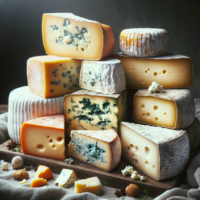
Cheese plays a significant role in Wolgos culture, serving as both a culinary staple and a reflection of their rich heritage. With a distinct preference for aged and mould-infused varieties, cheese production is deeply ingrained in Wolgos society, bridging the gap between tradition and taste. Central to Wolgos cheese production is the prized milk of aurochs, a robust breed of cattle. This milk serves as the primary source for crafting a diverse array of cheeses, each distinct in flavor and texture. Auroch milk cheese forms an integral part of Wolgos cuisine, offering a glimpse into their daily culinary traditions.
The Wolgos cheese selection boasts an array of options, not limited to auroch milk but also featuring cheeses made from the milk of pigs and goats. This diversity caters to a wide range of tastes and preferences, adding depth to their cheese offerings. Among the renowned cheeses in Wolgos cuisine are the maggot-infused varieties. These cheeses are known for their distinct texture and bold flavours. The presence of maggots imparts a unique character, creating a memorable culinary experience.
The Wolgos hold a distinct preference for aged and mould-infused cheeses. The process of aging and the addition of mould transform fresh cheese into delicacies with earthy nuances and mature textures. Soft and fresh cheeses are preferred as a side dish for a flavourful main dish.
Fermentation
A notable facet of Wolgos cuisine is the practice of aging game meats. This well-established technique involves marinating and preserving game meats meticulously, allowing them to develop intricate flavours and tender textures. Aged meats are a cornerstone of many Wolgos dishes, imparting a deep richness to their culinary creations.
Dairy products hold a significant role in Wolgos cuisine, with fermented milk drinks being particularly favored. These encompass a range of textures, from creamy to slightly acidic, often featuring assorted berries or tangy fruits. Fermentation extends the shelf life of dairy while adding a distinctive tanginess that complements other dishes.
Wolgos popularly produce a variety of vinegars, each with its distinct character and flavour profile. These vinegars, crafted through fermentation, play a crucial role in both preserving and flavouring dishes. Additionally, preserves akin to sauerkraut, featuring a medley of pickled vegetables and fruits, are cherished accompaniments that complement many Wolgos meals.
Another facet of Wolgos fermentation mastery is the creation of a diverse range of sauces and condiments. These artisanal creations are carefully crafted through fermentation processes, adding depth and complexity to their culinary offerings. These sauces and condiments are often used to enhance the flavours of various dishes, exemplifying the Wolgos' culinary craftsmanship
Alcohol
The Wolgos have a deep-rooted history of alcoholic beverage consumption, and their relationship with alcohol is as diverse as it is culturally significant. Over time, some foreign influences, particularly from the northern regions of Anaria, have become integrated into their drinking traditions. Notably, beer and lagers have found a place in Wolgos culture, blending with their indigenous alcoholic offerings.
Traditionally, the Wolgos people have had a preference for distilling fermented grains into potent spirits, akin to vodka. These strong and robust spirits have been a cornerstone of their drinking culture for generations, celebrated for their potency and versatility in crafting various libations.
Given their penchant for milk and milk products, the Wolgos have ingeniously fermented dairy to produce a range of high-proof spirits. This innovation has resulted in an array of dairy-based alcoholic beverages, which can be enjoyed in their pure form or used as a base for further creations. Fermented milk drinks reminiscent of kumis have also found favour among the Wolgos. These beverages, often slightly effervescent and mildly alcoholic, are sometimes enhanced with added spirits for an extra kick. This unique blend of fermented milk and strong spirits creates a drink that is both refreshing and potent, offering a one-of-a-kind taste experience.
One distinctive aspect of Wolgos alcoholic drinks is their propensity to incorporate milk or milk-based products as a base. These creamy foundations provide a velvety backdrop for a wide array of flavourings, including fruits, coffee, chocolate, and even pine berries.
Haute Cuisine
Human meat

The Wolgos have an intricate history that includes a controversial practice of cannibalism, a fact widely recognized despite the distinctions in subspecies. This practice involves the consumption of human flesh, a behaviour rooted in their evolutionary past as hominids. Notably, while they do not consume the flesh of their fellow Wolgos, their historical penchant for human meat is a complex aspect of their culinary heritage.
In the modern era, this tradition has faced significant challenges and transformations. The abolition of slavery has had a profound impact, drastically reducing the supply of prime human meat that was once more readily available. Currently, human meat remains an expensive commodity, even with a legal framework in place compelling non-Wolgos individuals in Hergom to release the bodies of their deceased to specialized companies for assessment. If these bodies are deemed healthy and prime, they are then butchered, and family members receive a token recompense.
One of the most sought-after forms of human meat is known as mellified corpse, a product renowned for its exceptional quality but prohibitively expensive to produce. Traditionally, individuals, often Eokoesr or other humans, would undergo a unique process. They would be forced to cease consuming anything except honey and ever-decreasing amounts of water for a span of weeks or even months. This strict diet would ultimately lead to the death of the individual, whose corpse would then be meticulously preserved in jars immersed in honey. Liver from corpses that had undergone a gentler mellification process over several months to a year is considered one of the highest-quality ingredients.
In the contemporary Wolgos society, human meat consumption has become a rare and exclusive practice. It is primarily the domain of the affluent or reserved for special celebratory occasions. For most Wolgos, partaking in this tradition occurs only once or twice a year at most, marking a significant departure from its historical prevalence.
Forbidden cuisine
Example of a Wolgos Haute Cuisine
The Solar solstice dinner hosted at the International Council of Nations (ICoN) Hergom Mission is a captivating display of Wolgos Haute Cuisine, meticulously designed to dazzle a global audience. This grand event, graced by foreign dignitaries, serves as a showcase of the Wolgos' culinary excellence and their pride in their unique heritage. Each dish featured on the menu carries profound cultural significance, providing a culinary journey into the heart of Wolgos tradition. These thoughtfully selected creations offer a genuine representation of the Wolgos' profound relationship with food, steeped in centuries-old customs. This event allows the Wolgos to extend their warm hospitality to foreign dignitaries, highlighting their cultural achievements and cuisine of the Wolgos people.
The following is the menu for the 7689 Solar solstice dinner:
